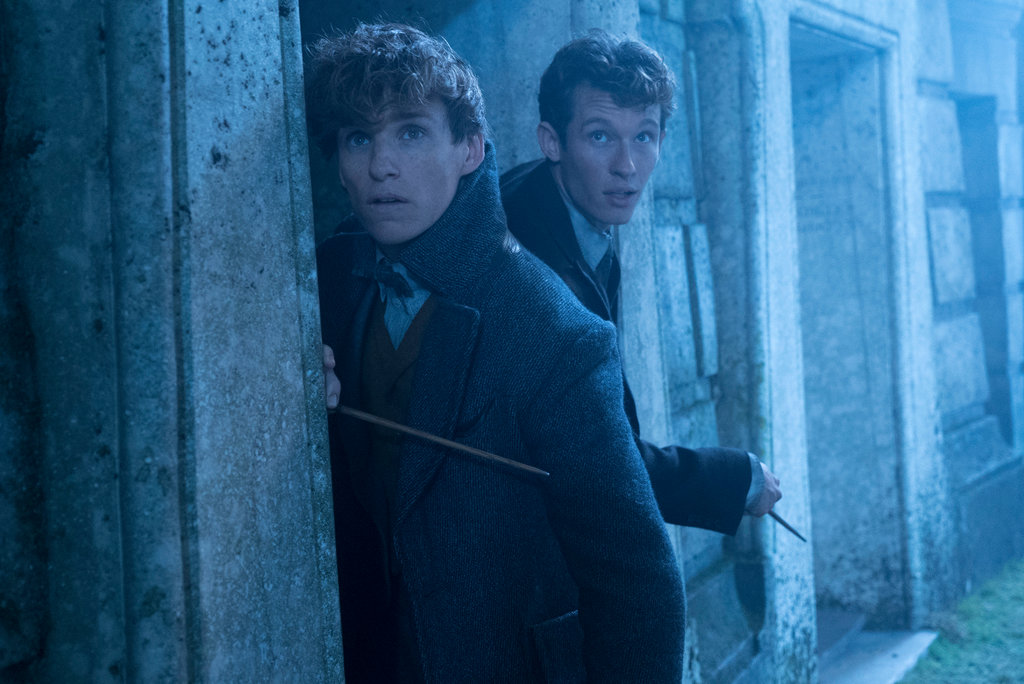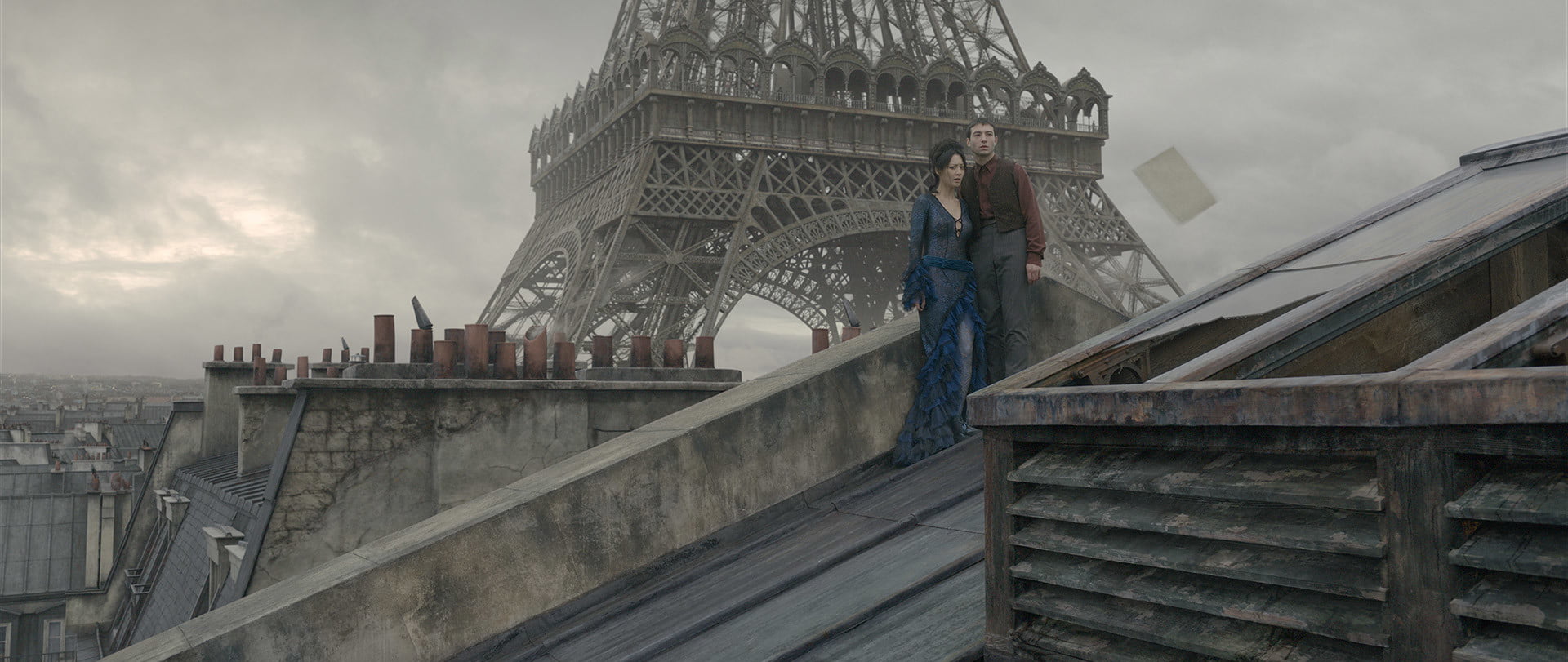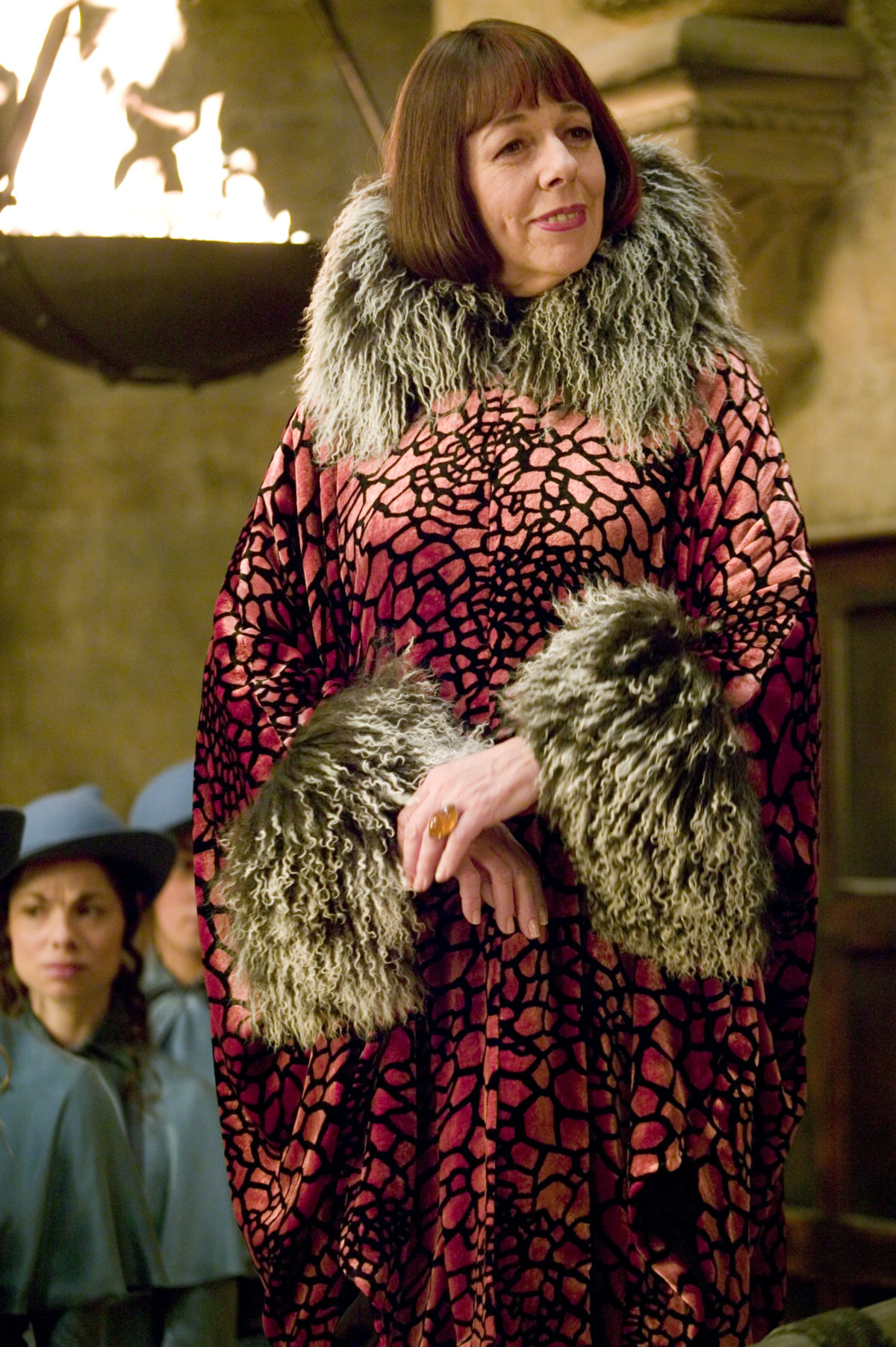Colette in the Wizarding World
by Dr. Beatrice Groves
Sidonie-Gabrielle Colette (January 28, 1873–August 3, 1954) – a writer known by the mononym Colette – was born on this day, 150 years ago. Colette is one of J.K. Rowling’s most beloved authors and someone who has influenced her since she read Claudine at School at age 11 – a novel that she says has “stayed with me ever since.”
The Claudine novels remained on Rowling’s bookshelf when she was writing Harry Potter and the Goblet of Fire. You can see the pale mint of its Modern Penguin Classics spine in the bookshelf photo used for the back cover of Bloomsbury’s adult edition of Goblet of Fire (or at least you can once guided by the excellent decoding abilities of Nick Jeffery!). In both Fantastic Beasts: The Crimes of Grindelwald and Goblet of Fire, Colette – Rowling’s favorite French author – plays an important role. This editorial will look at the importance of France to Rowling and argue that Colette is a major influence in the setting of Crimes of Grindelwald as well as the clear source for the Christian name of the headmistress of Beauxbatons, Madame Maxime. Claudine at School was the first “grown-up” novel Rowling read. It is particularly pleasing, therefore, to find it influencing Goblet of Fire since the appearance of a French school in this novel itself is “symbolic. Harry’s horizons are literally and metaphorically widening as he grows older.”
Both the Harry Potter and the Fantastic Beasts franchises are centered on anglophone worlds – the first series is almost entirely British; the second starts in America, and its four central characters are three Americans and one Brit. It is in Goblet of Fire that the Harry Potter universe first widens to consider the international wizarding community, and as with Crimes of Grindelwald, it is France that plays the most important role in this initial wider perspective. France is the setting of the second Fantastic Beasts film (and we meet there the most famous non-British wizard to appear in Harry Potter – Nicolas Flamel), and it is likewise home to Fleur Delacour, the most important non-British character in Harry Potter whom we first meet in Goblet of Fire. Beauxbatons and Fleur are central to the newly international focus of Goblet of Fire, creating a literary symbolism through which the structure of the series echoes the growth of its hero – opening out to encompass the international wizarding world as Harry’s own world expands.
France was important in Rowling’s – as well as Harry’s – development into adulthood since it was the first place she lived abroad. She has spoken of this time as formative:
I spent a year in Paris [in 1985]… I was teaching students in a lycée, basically a comprehensive on the outskirts of Paris. It was a very particular experience going away. I left a boyfriend back in Britain, and we were all quite young, and we were all quite broke… We had some wonderful adventures during that time… There was a sense of being lost but in quite a nice way, I suppose. We were exploring life a lot at that time.
Colette forms a literary equivalent for Rowling of this time in France, being the first “grown-up” writer she read as a child. I’m particularly interested in authors, like Colette, whom Rowling read when she was young because it seems most likely that it is those authors who will be laid deepest in her subconscious and hence be the books most likely to influence Harry Potter. (I’d love to know what texts she studied for O- and A-level, for example: If anyone was studying French or English at sixth form near Gloucestershire – or even better at Wyedean – in the 1980s, do let me know!) When asked what books have shaped her as a writer, Rowling has stressed the reading of her youth – including Colette:
I struggle to answer this because I think you’re shaped by literally everything you read when you’re young, and as my mother filled the house with books, my taste was catholic, to say the least. I read everyone from Georgette Heyer to Ian Fleming to Dodie Smith to William Thackeray. I loved Wodehouse and Waugh, Katherine Mansfield and Colette. All of them taught me different ways to create a world populated by living, breathing characters, so that the reader never notices the pasteboard, the strings and levers.
Over and over again, Rowling has named Colette as a favorite in interviews, describing her as an untouchable ideal and deciding on her collected works as one of the three books she’d take to a desert island (along with Shakespeare and P.G. Wodehouse). Rowling has described Colette’s style as inimitable:
I could never write the way Colette did. I’ve never found anything to match her descriptive passages, ever. She was a very sensual writer, and way beyond her time… I absolutely bow to Colette, but I think if she could hear me, she would probably tell me where to get lost, because she was that kind of woman.
Rowling is interested in Colette as a woman as well as a writer, and she is indeed a fascinating character. Take, for example, Colette’s choice to be known by a mononym, which is a striking act of self-confidence, particularly when put into a French context, for some of the most famous French thinkers and writers have chosen to be known by mononyms. Most renowned is Voltaire – the mononym of François-Marie Arouet, who took the moniker in 1718 after his imprisonment in the Bastille:
The new name combined several features. It was an anagram for a Latinized version of his family surname, ‘Arouet, l[e] j[eune]’; it reversed the syllables of the name of the town where his father came from, Airvault; and it has implications of speed and daring through similarity to French expressions such as ‘voltige,’ ‘volte-face,’ and ‘volatile.’
Colette put herself into the company of not only Voltaire but also literary giants such as Molière (the mononym of the 17th-century dramatist and actor Jean-Baptiste Poquelin [1622–73]) and the 19th-century novelist Stendhal (otherwise Marie-Henri Beyle). Colette claimed exalted company when choosing her nom de plume, and it was confidence rewarded with popularity and renown in her lifetime. When she died, she was given a state funeral – the first female author to be accorded such an honor.
Colette lived much of her life in Paris, and she is buried there, in Père Lachaise Cemetery. This may mark Colette’s influence on Crimes of Grindelwald, in which the climactic battle takes place in this famous cemetery. Writers are often taphophiles – Ebenezer Scrooge’s name came from Dickens misreading a grave in an Edinburgh graveyard, and Tom Riddle’s name, as is well-known, came from another tombstone in the same city (I’ve written in detail about the surprising influence of Edinburgh’s graveyards on Harry Potter). Graveyards and cemeteries are full of half-heard human stories, and crime writers, in particular, often find them conducive places for inspiration. P.D. James, for example (another of Rowling’s favorites), loved piecing together stories from the hints left on tombstones (see The Girl Who Loved Graveyards), and Rowling has just set her most recent crime novel in Highgate Cemetery (the place where Crimes of Grindelwald’s Père Lachaise was, in fact, filmed). Given the inspiration Rowling has long drawn from graveyards and cemeteries, it seems pretty certain that she would have been one among the 3.5 million people who visit Père Lachaise annually when she spent her year living in Paris. As a passionate lover of Colette’s writing, she surely would have made the pilgrimage to see her grave – a visit that perhaps sowed the seed for the finale of Crimes of Grindelwald.

Colette may also be linked in a wider way to the reason Rowling chose Paris as the setting for Crimes of Grindelwald:
Why Paris? In the first movie, we were in America, where the wizarding community felt quite locked down. For this film, I was looking to move to a place where there would be a more fluid relationship between the magic and the mundane. And in the 1920s, that had to be Paris.
Paris in the 1920s represents for Rowling “a place where there would be a more fluid relationship between the magic and the mundane.” I have written about this fluidity in relation to mermaids and snake women in the wizarding world – in particular, the connections between Nagini’s story and the French Melusine myth (in my chapter in Lana Whited’s forthcoming collection of Harry Potter essays The Ivory Tower, Harry Potter, and Beyond). But I think Colette’s life and writings are also part of why Rowling felt that the location for this “fluid relationship… had to be Paris.” In 1920, Colette published Chéri – one of Rowling’s favorite novels – and Colette’s innovative novels in this decade (which include The Vagabond, Le Blé en Herbe, and La Naissance du Jour) all express a desire for greater freedom for women in their lives and loves. The freedom and fluidity of sexual relationships in Colette’s writings in 1920s Paris were echoed likewise in the life she was living there – she divorced for the second time in the 1920s (due in part to her affair with her stepson) and met her third, also significantly younger, husband. Paris in Crimes of Grindelwald represents “a more fluid relationship between the magic and the mundane” – and specifically, for Queenie, this means finding hope here that she will be able to love and marry someone whom her own society’s laws and mores rejects. Queenie flees to Paris and hopes to find there the freedom celebrated in Colette’s life and work.
Rowling would have known the rough outline of Crimes of Grindelwald by at least 2014 when Warner Bros. announced that Fantastic Beasts would be “at least” a trilogy. This means that her choice of Paris as a setting may well have been influenced by reading Judith Thurman’s fantastic biography of Colette, Secrets of the Flesh (1999) (which incidentally ends, like Rowling’s film, at Père Lachaise). In the years prior to the announcement of the Fantastic Beasts sequels, Rowling regularly mentioned this biography in interviews – describing it to the New York Times in 2012 as one of her “all-time favorites” and in 2013 as a “stunning biography” that she loves to reread – “[it’s] a fixture on the bedside bookshelves.”
Thurman writes about the subject of Americans traveling to Paris at the beginning of the 20th century in search of sexual freedom – what Thurman calls “puritan vigor tempered by French decadence” (Secrets of the Flesh 138) – and this is one aspect of what Rowling’s “more fluid relationship between the magic and the mundane” means. Of the central characters who travel to Paris in Crimes of Grindelwald, almost all (Queenie, Tina, Jacob, and Credence) are American by birth or adoption. Rowling has written a classic “Americans in Paris” story line – echoing texts such as Henry James’s The American (1876–7), which was surely influenced by his own experience as a young American in Paris. James’s experience of the French-American culture clash came when he lived in Paris in 1875–6. While there, he met successful authors such as Ivan Turgenev, Gustave Flaubert, Emile Zola, and Guy de Maupassant. (Incidentally, there is a possible – more fundamental – link with Rowling for the latter author, who has been described as “one of her favorite writers.” In 2011, when she appeared on the BBC show Who Do You Think You Are? Rowling said, “I would love to know who my great-grandfather’s father was. He was illegitimate, but his mother [Rowling’s great-great-grandmother Salomé Volant, whom she writes into the Lestrange family tree] fell pregnant while working as a maid next door to the notoriously promiscuous French writer Guy de Maupassant. A girl can dream…”)

Henry James did not find in Paris precisely what he was looking for, but when his close friend and acolyte Edith Wharton likewise went to live in Paris, her experience was more fruitful. She went a decade or so before Tina and Queenie (in 1907), leaving “what she deemed a self-righteous and cynical America to travel around Europe. When she arrived in France, Wharton saw Paris as an ideal escape from the United States’ restrictive norms.” Edith Wharton (like Maupassant before her) was a writer who found amorous and sexual freedom in Paris – the freedom that Queenie seeks there, likewise freeing herself from the restrictive norms of her society, which does not approve of relationships between the magical and No-Maj communities. While American writers such as James and Wharton may have been in Rowling’s mind with her Americans-in-Paris story line, it is Colette who embodies (both textually and biographically) the freedom of 1920s Paris and the fulfillment that Queenie hopes to find there.
Claudine at School is a book that celebrates sexual freedom – the heroine explores her own sexuality entirely unrestricted by the cultural mores of age or gender. The novel ends with a ball to mark the arrival of an august visitor to the town (like the Yule Ball celebrating the visitors to Hogwarts), and it is a ball that, like the Yule Ball, brings sexual jealousy to the fore. Goblet of Fire, like Claudine at School, is a coming-of-age school story in which the trio starts – though in a rather more restrained and British way – to become more aware of the erotic side of their natures.
Rowling is a long-term lover of Colette, so she would not have needed Thurman’s biography to bring the Claudine novels to mind – but the timing (Thurman’s biography was published in 1999 when Rowling was working on Goblet of Fire) is suggestive. We know Rowling was rereading it in 2012 as she planned the Fantastic Beasts sequels, but she may have originally read it as she penned Goblet of Fire, and if so, it would have brought her old love of Colette to the forefront of her mind. Goblet of Fire is, of course, the first time that we hear about the French wizarding school Beauxbatons and its headmistress Olympe Maxime – of whom Rowling writes on Pottermore:
Headmistress Olympe Maxime is (in spite of her protestations to the contrary) half-giantess; brilliant, elegant and undeniably awe-inspiring.
Olympe is a grandly cratylic name for a French half-giantess, recalling as it does Mount Olympus. But it seems likely that Rowling first thought of this joke because she had read a novel about a French school in which the headmistress is likewise named Olympe: Colette’s Claudine at School. Thurman’s 1999 biography describes in detail how the headmistress at Claudine’s fictional school, Olympe Sergent, was modeled after the headmistress at Colette’s own school, Olympe Terrain (Secrets of the Flesh 40-41).

The French students treat Madame Maxime with respect, and Goblet of Fire notes this difference in style between British and French politesse:
When their headmistress appeared, the pupils from Beauxbatons leapt to their feet. A few of the Hogwarts students laughed. The Beauxbatons party appeared quite unembarrassed, however, and did not resume their seats until Madame Maxime had sat down on Dumbledore’s left-hand side.” (GoF 250)
This respectful treatment of teachers is old-fashioned (as well as foreign to the Hogwarts students), placing Beauxbatons in the context of Colette’s early 20th-century writing when students would always have stood to attention when the headmistresses entered the room.
In both Goblet of Fire and Crimes of Grindelwald, France plays a similar role for the heroes as it played (both literally and literarily) in Rowling’s own life. France in these works, as often in anglophone texts, feels like a more “grown-up” and sexually sophisticated place than Britain or America – fittingly for Rowling’s own formative time there and her formative love of Colette (as well as the tantalizing possibility of an illicit liaison with a famous French writer in Rowling’s own bloodline). Colette’s lush prose and the erotic freedom of her life and writing embody the fluidity and freedom of 1920s Paris and are also a fitting context for the coming-of-age aspect of Goblet of Fire. And it is pleasing to find that Olympe Terrain has the surprising (and unique?) honor of having two literary headmistresses named after her.
Dr. Beatrice Groves teaches Renaissance English at Trinity College, Oxford, and is the author of Literary Allusion in Harry Potter, which is available now. Don’t miss her earlier posts for MuggleNet – such as “Solve et Coagula: Part 1 – Rowling’s Alchemical Tattoo,” – all of which can be found in Bathilda’s Notebook. She is also a regular contributor to the MuggleNet podcast Potterversity.

